


xxxxxThe French composer Léo Delibes produced his now famous ballet Coppélia in 1870 - the story of a mechanical doll that comes to life - and followed this six years later with his equally successful ballet Sylvia, set in pagan Greece. These two works, by the quality of their light, expressive music, played an important part in he development of the ballet as an art form. He also produced a number of operas, notably an exotic, oriental tale entitled Lakmé, produced in 1883, and his love story Kassya, left unfinished but completed by the French composer Jules Massenet. As an organist he wrote both secular and sacred choral music, and his many songs included the popular The Girls of Cadiz. Early in his career, while producing a series of comic operettas for the Paris theatre, he worked alongside his fellow countryman Jacques Offenbach, a composer whose major work, The Tales of Hoffmann, was produced in 1881. Delibes’ charming, tuneful music, and his superb orchestral sense influenced, among others, the Russian composer Tchaikovsky and the two French composers Saint-Saëns and Debussy.
LÉO DELIBES 1836 - 1891 (W4, Va, Vb, Vc)
Acknowledgements
Delibes: lithograph by the American artist Chase Emerson (1874-1922), contained in The Lure of Music by the American music critic Olin Downes (1886-1955), first published in 1922. Flower Duet: date and artist unknown. Saint-Saëns: pastel on paper by the Italian artist Alberto Rossi (1825-1921), 1903 – Bibliothèque de l’Opera Garnier, Paris. Fauré: based on photograph by unknown artist.
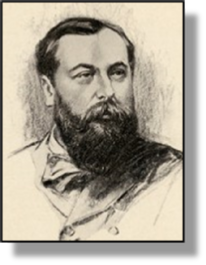 xxxxxThe French composer Léo Delibes is best known for his ballet Coppélia, produced in 1870 and seen today as his most popular piece. His works, noted for their elegant style and sparkling light music, included the ballet Sylvia - regarded by many as his masterpiece - the operas Jean de Nivelle and Lakmé, and the comedy Le Roi l’a dit (The King Said So).
xxxxxThe French composer Léo Delibes is best known for his ballet Coppélia, produced in 1870 and seen today as his most popular piece. His works, noted for their elegant style and sparkling light music, included the ballet Sylvia - regarded by many as his masterpiece - the operas Jean de Nivelle and Lakmé, and the comedy Le Roi l’a dit (The King Said So).
xxxxxDelibes was born in Saint-Germain-du-Val, Sarthe, and, like Bizet after him, studied musical composition at the Paris Conservatory. Once qualified he worked as a rehearsal accompanist and choral master for the Théatre Lyrique, and it was during this period that he produced a series of amusing farces and comic operettas for the commercial theatre, working alongside a group of light-opera composers which included Jacques Offenbach, a composer well-known for his success in this genre. Inx1864, however, as second choral master of the Paris Opera House, he turned to the writing of ballet music, and in 1866, in collaboration with the Austrian composer Ludwig Minkus (1827-1917), produced La Source, a work which proved popular for its Oriental theme and established his reputation as a promising composer of dance music.
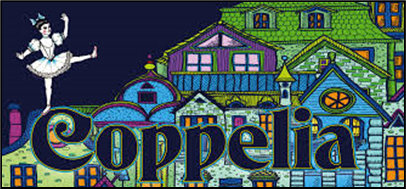
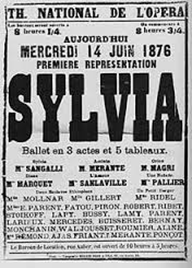 xxxxxThen four years later, working on his own, he produced the music for Coppélia, a delightful tale adapted from a story entitled Der Sandman (The Sandman) by the German writer Ernst Hoffmann. Centred around the idea of a mechanical doll brought to life at the hands of the eccentric toymaker Dr. Coppelius, it marked, by the quality of its light, expressive music, a distinctive advance in the development of ballet music. Its charming, amusing story, and its attractive, tuneful melodies, delighted the theatre-going public, but the early performances were seriously interrupted by the outbreak of the Franco-Prussian War, and it was not until this conflict and the siege of Paris were over that the piece gained wide popularity. It was followed by two other ballets, the more notable being the mythological Sylvia of 1876 (see poster above). Set in pagan Greece, the quality of its music equalled if it did not surpass that of Coppélia, and was judged by the great Russian composer Pyotr Tchaikovsky as better than his own ballet music. “Had I heard this music earlier,” he confessed, “I would not have written Swan Lake”.
xxxxxThen four years later, working on his own, he produced the music for Coppélia, a delightful tale adapted from a story entitled Der Sandman (The Sandman) by the German writer Ernst Hoffmann. Centred around the idea of a mechanical doll brought to life at the hands of the eccentric toymaker Dr. Coppelius, it marked, by the quality of its light, expressive music, a distinctive advance in the development of ballet music. Its charming, amusing story, and its attractive, tuneful melodies, delighted the theatre-going public, but the early performances were seriously interrupted by the outbreak of the Franco-Prussian War, and it was not until this conflict and the siege of Paris were over that the piece gained wide popularity. It was followed by two other ballets, the more notable being the mythological Sylvia of 1876 (see poster above). Set in pagan Greece, the quality of its music equalled if it did not surpass that of Coppélia, and was judged by the great Russian composer Pyotr Tchaikovsky as better than his own ballet music. “Had I heard this music earlier,” he confessed, “I would not have written Swan Lake”.
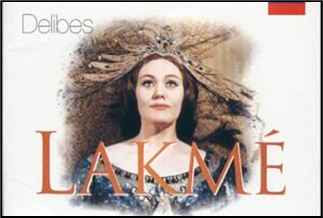 xxxxxBut Delibes’ talent was not confined to the ballet. He wrote a number of successful operas, one of which, Lakmé, became popular on both sides of the Atlantic and rivalled Bizet’s Carmen in popularity. Produced in five acts in 1883, it was an exotic, oriental tale full of romance and mystery. Based on the 1880 novel Rarahu by the French writer Pierre Loti, it contained two well-known
xxxxxBut Delibes’ talent was not confined to the ballet. He wrote a number of successful operas, one of which, Lakmé, became popular on both sides of the Atlantic and rivalled Bizet’s Carmen in popularity. Produced in five acts in 1883, it was an exotic, oriental tale full of romance and mystery. Based on the 1880 novel Rarahu by the French writer Pierre Loti, it contained two well-known 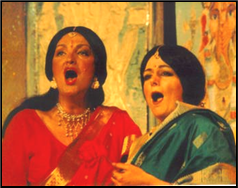 pieces, The Bell Song and The Flower Duet (illustrated). His last opera, a tragic love story entitled Kassya, was left unfinished, but was completed by the French composer Jules Massenet and produced in 1893. In addition, Delibes composed a number songs - including the popular Les filles de Cadiz (the Girls of Cadiz) - and as a church organist (notably at Saint Pierre de Chaillot) he produced some secular as well as sacred choral music.
pieces, The Bell Song and The Flower Duet (illustrated). His last opera, a tragic love story entitled Kassya, was left unfinished, but was completed by the French composer Jules Massenet and produced in 1893. In addition, Delibes composed a number songs - including the popular Les filles de Cadiz (the Girls of Cadiz) - and as a church organist (notably at Saint Pierre de Chaillot) he produced some secular as well as sacred choral music.
xxxxxIn 1881 he returned to the Paris Conservatory as professor of advanced composition, and three years later was elected a member of the French Academy. His music, full of charm and elegance, together with his superb orchestral sense, influenced the work, among others, of Tchaikovsky and the French composers Saint-Saëns and Debussy.
xxxxxIncidentally, while at the Paris Conservatory Delibes was taught by the French composer and music critic Adolphe Adam, whose many attractive works included the opera Si j’etais roi (If I were King), first performed in 1852, and the romantic ballets Giselle of 1841 and Le Corsaire of 1856. ……
Xxxxx…… In 1882 Delibes composed a suite of six dances for Victor Hugo’s play Le roi s’amuse, (The King’s Pleasure) produced at the Comédie-Francaise in 1882. This was the play which the Italian operatic composer Giuseppe Verdi turned into his masterpiece Rigoletto back in 1851. ……
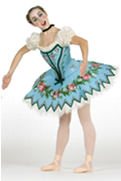 xxxxx…… Thexoriginal Coppélia was danced by Giuseppina Bozzacchi, a young sixteen-year-old Italian student. Her brilliant performance gave promise of a glittering career, but the following year she contracted cholera during the siege of Paris and died on her seventeenth birthday. ……
xxxxx…… Thexoriginal Coppélia was danced by Giuseppina Bozzacchi, a young sixteen-year-old Italian student. Her brilliant performance gave promise of a glittering career, but the following year she contracted cholera during the siege of Paris and died on her seventeenth birthday. ……
xxxxx…… As noted earlier, during the early part of his career the French composer Jacques Offenbach worked with Delibes, producing burlesques and comic operettas for the Paris stage. As we have seen (1858 Va), he gained fame and not a little notoriety with his Orphée aux enfers (Orpheus in the Underworld) of 1858, a satirical “buffoonery” which provided the music for the lively Can-Can. Today, he is especially remembered for his barcarolle, the boat-song of the Venetian gondoliers, featured in his operatic masterpiece The Tales of Hoffmann, produced after his death in 1881.
Including:
Camille Saint-Saëns
and Gabriel Fauré

Vb-1862-1880-Vb-1862-1880-Vb-1862-1880-Vb-1862-1880-Vb-1862-1880-Vb-1862-1880-Vb
xxxxxCamille Saint-Saëns (1835-1921), one of the French composers influenced by the works of Léo Delibes, showed a remarkable musical ability from an early age, and later became well known as a virtuoso pianist and organist. He composed over 300 works, including many symphonies, concertos and sonatas. He also wrote numerous pieces for the piano and organ and, like Delibes, produced solo songs and a number of sacred and secular choral works. He is best known today for his ghostly symphonic poem Danse Macabre of 1875, his grand opera Samson and Delilah, staged two years later, and his orchestral fantasy Carnival of the Animals, first performed in 1886. He travelled widely during his career and gained an international reputation. His elegant, polished style was criticised by some for lacking emotion, but much of his work was remarkable for its melodic invention and the beauty of his harmonies and chords. Among those who admired his music was his life-long friend Liszt, and the composers Rossini, Wagner, Berlioz and Gounod. He was the first composer to write specifically for the cinema.
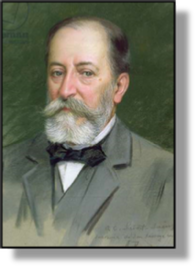 xxxxxCamille Saint-Saëns (1835-1921) one of the French composers influenced by the works of Léo Delibes, was born in Paris and, like Mozart and Mendelssohn before him, showed a remarkable musical ability from an early age. Taught initially by his mother and a great aunt, he quickly became an accomplished pianist. He began composing his own piano pieces at the age of five, and five years later was playing Beethoven’s piano concertos in public.
xxxxxCamille Saint-Saëns (1835-1921) one of the French composers influenced by the works of Léo Delibes, was born in Paris and, like Mozart and Mendelssohn before him, showed a remarkable musical ability from an early age. Taught initially by his mother and a great aunt, he quickly became an accomplished pianist. He began composing his own piano pieces at the age of five, and five years later was playing Beethoven’s piano concertos in public.
xxxxxHaving attended the Paris Conservatory from 1848 and gained the first prize as an organ scholar, he became organist at the church of Saint-Merry in Paris in 1853 and, four years later, at the age of 22, was appointed organist at the famed Church of La Madeleine, a prestigious position which he held for many years. By 1861, the year he took up the post of piano professor at the École Niedermeyer (a school in Paris specialising in the teaching of church organists and choir directors), he was already well known as an outstanding composer of orchestral music, and he was in constant demand as a virtuoso pianist and organist.
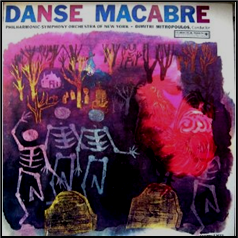 xxxxxDuring his long musical career Saint-Saëns composed over 300 pieces, and was the first composer to write specifically for the cinema. His works included symphonies, concertos for piano, violin and cello, and sonatas for oboe, clarinet, bassoon and piano. Outstanding among these are his second and fourth piano concertos, his third violin concerto, his second cello concerto, and his majestic third symphony, dedicated to Franz Liszt. He also produced many pieces for the organ and piano - including his Variations on a Theme by Beethoven - and, like Delibes, wrote many solo songs and a number of sacred and secular choral works. Today, however, Saint-Saëns is principally remembered for four orchestral works: his symphonic poem Danse Macabre of 1875, his grand opera Samson and Delilah of 1877, and his Organ Symphony and Carnival of the Animals, both produced in 1886.
xxxxxDuring his long musical career Saint-Saëns composed over 300 pieces, and was the first composer to write specifically for the cinema. His works included symphonies, concertos for piano, violin and cello, and sonatas for oboe, clarinet, bassoon and piano. Outstanding among these are his second and fourth piano concertos, his third violin concerto, his second cello concerto, and his majestic third symphony, dedicated to Franz Liszt. He also produced many pieces for the organ and piano - including his Variations on a Theme by Beethoven - and, like Delibes, wrote many solo songs and a number of sacred and secular choral works. Today, however, Saint-Saëns is principally remembered for four orchestral works: his symphonic poem Danse Macabre of 1875, his grand opera Samson and Delilah of 1877, and his Organ Symphony and Carnival of the Animals, both produced in 1886.
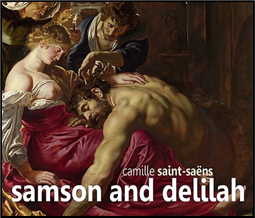 xxxxxDanse Macabre, based on the ancient superstition that on the night of Halloween the dead come out of their graves and dance to the music of Death as he plays on his fiddle, proved immensely popular. Noted for its use of the xylophone to imitate the sound of the rattling bones of the cavorting skeletons, this ghostly but nonetheless elegant music has survived down the years, and has been used on many occasions in sound tracks for films and television programmes. Samson and Delilah, the only one of his thirteen operas to achieve lasting success, was originally barred from the French stage on the grounds that it trivialised a serious biblical subject. As a result, it was promptly translated into German and was produced at Weimar in December 1877. It was not heard in France until 1890 and even then its premier was relegated to the provincial city of Rouen. Though lacking somewhat in dramatic action, the opera is full of attractive melodies, the best known being the Bacchanalia from Act III. The production at Weimar owed much to the support of Franz Liszt, whom Saint-Saëns first met in 1852. The Hungarian composer became a fervent admirer of his young friend’s music and did a great deal to further his career.
xxxxxDanse Macabre, based on the ancient superstition that on the night of Halloween the dead come out of their graves and dance to the music of Death as he plays on his fiddle, proved immensely popular. Noted for its use of the xylophone to imitate the sound of the rattling bones of the cavorting skeletons, this ghostly but nonetheless elegant music has survived down the years, and has been used on many occasions in sound tracks for films and television programmes. Samson and Delilah, the only one of his thirteen operas to achieve lasting success, was originally barred from the French stage on the grounds that it trivialised a serious biblical subject. As a result, it was promptly translated into German and was produced at Weimar in December 1877. It was not heard in France until 1890 and even then its premier was relegated to the provincial city of Rouen. Though lacking somewhat in dramatic action, the opera is full of attractive melodies, the best known being the Bacchanalia from Act III. The production at Weimar owed much to the support of Franz Liszt, whom Saint-Saëns first met in 1852. The Hungarian composer became a fervent admirer of his young friend’s music and did a great deal to further his career.
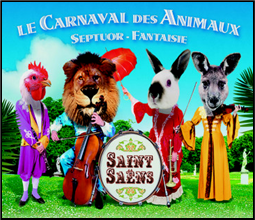 xxxxxSaint-Saëns’ massive third symphony, the so-called Organ Symphony, often performed today because of its remarkable combination of the organ and two pianos, was dedicated to the memory of Liszt, who died in 1886. And it was in that year that Saint-Saëns produced his now famous Carnival of the Animals, a musical suite of fourteen movements depicting, among others, the lion, the donkey, the hen and the tortoise. He called it his “grand zoological fantasy”. In fact, this delightful orchestral make-believe - perhaps the most popular and best-loved of all his works - was not performed in full during his lifetime. He gave private performances but, fearing that such a trivial piece would harm his reputation as a serious composer, only one movement, Le Cygne (The Swan), was made public. And another popular work was his captivating
xxxxxSaint-Saëns’ massive third symphony, the so-called Organ Symphony, often performed today because of its remarkable combination of the organ and two pianos, was dedicated to the memory of Liszt, who died in 1886. And it was in that year that Saint-Saëns produced his now famous Carnival of the Animals, a musical suite of fourteen movements depicting, among others, the lion, the donkey, the hen and the tortoise. He called it his “grand zoological fantasy”. In fact, this delightful orchestral make-believe - perhaps the most popular and best-loved of all his works - was not performed in full during his lifetime. He gave private performances but, fearing that such a trivial piece would harm his reputation as a serious composer, only one movement, Le Cygne (The Swan), was made public. And another popular work was his captivating 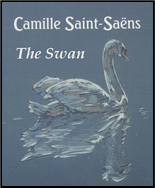 Wedding Cake Waltz.
Wedding Cake Waltz.
xxxxxSaint-Saëns travelled widely during his lifetime and gained an international reputation as a composer, pianist, organist and conductor. He made his first visit to England in 1870 - to escape the Franco-Prussian War - and then toured Spain and Portugal in 1880. The following year he separated from his wife, whom he had married in 1875 (he was, in fact, a homosexual), and it was then that he began extensive tours of Europe, North Africa, the Middle East and the Americas. During his travels he produced a number of works of local colour, such as his Suite algérienne, La Jota aragonese, “Africa” Fantasy and Caprice Arabe, and he composed music for the coronation of Edward VII in 1902. When his mother died in 1888 he settled for a while in the Canary Islands, but he spent his last years in Algiers, and it was here that he died. He was given a state funeral at La Madeleine, the church where he had been the organist for some twenty years, and was buried in the cemetery at Montparnasse.
xxxxxHis immense output encompassed a large variety of instrumental and vocal music, and he was the first French composer to produce a symphonic poem, an orchestral composition inspired by a poem, a story or some other art form. He started his career as something of a pioneer, but later in life became a reactionary, criticising in particular the works of Debussy and Richard Strauss. He was a master of classical form, and his music became progressively French in character, but his elegant, polished style, precise in detail, was seen by some critics as uninspired and lacking in emotion. Be that as it may, a number of his works have survived the test of time, due in no small part to his melodic invention and the beauty of his harmonies and chords. Among those composers who admired his talent - be it as a composer, pianist or organist - where his close friend Liszt, the Italian Rossini, the German Richard Wagner and the Frenchmen Berlioz and Gounod.
xxxxxIncidentally, in 1871, together with the French poet Romain Bussine, Saint-Saëns founded the
Société Nationale de Musique, aimed at promoting the development of French chamber and orchestral music. Its early members included César Franck, Jules Massenet and Gabriel Fauré. ……

xxxxx…… When composing the Carnival of Animals, he chose to represent the tortoise by taking the Infernal Gallop from Offenbach’s Orpheus in the Underworld - the lively music adopted by the music hall dance the Can-Can -, slowing it down to a snail’s pace, and playing it on the cello! ……
xxxxx…… Saint-Saëns was not just a talented musician. Throughout his life he showed a lively interest in geology, archaeology, botany and mathematics, and he wrote articles on scientific matters, including acoustics and astronomy. He also wrote a volume of poetry entitled Rimes familières and a farce called La Crampe des écrivains. Apart from writing critical pieces on music, poetry and the stage, he produced a series of popular travel books during his wanderings abroad, and these were published under the nom de plume Sannois.
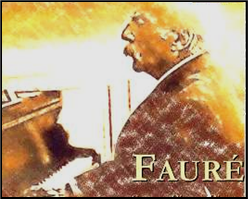
xxxxxOnexof his pupils from his days at the École Niedermeyer was the French composer Gabriel Fauré (1845-1924). Saint-Saëns encouraged and supported him throughout his career. Like his teacher, Fauré excelled as an organist and pianist, though not to the same high standard. He concentrated on pieces of chamber music, but was also a fine song composer, and his works were noted for their subtlety, elegance and refinement.
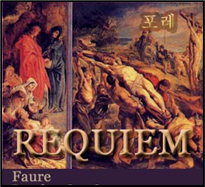
xxxxxAmong his best known works are his Requiem of 1888 (composed “for the pleasure of it”), his music for Maeterlinck’s play Pelléas et Mélisande, produced in 1898, and his opera Pénélope, first shown in 1913. Like Saint-Saëns, he served as organist at the prestigious Church of the Madeleine, and he was then appointed professor of composition at the Paris Conservatory in 1896, becoming its director in 1905. Among his students was the French composer Maurice Ravel.






 xxxxxThe French composer Léo Delibes is best known for his ballet Coppélia, produced in 1870 and seen today as his most popular piece. His works, noted for their elegant style and sparkling light music, included the ballet Sylvia -
xxxxxThe French composer Léo Delibes is best known for his ballet Coppélia, produced in 1870 and seen today as his most popular piece. His works, noted for their elegant style and sparkling light music, included the ballet Sylvia -
 xxxxxThen four years later, working on his own, he produced the music for Coppélia, a delightful tale adapted from a story entitled Der Sandman (The Sandman) by the German writer Ernst Hoffmann. Centred around the idea of a mechanical doll brought to life at the hands of the eccentric toymaker Dr. Coppelius, it marked, by the quality of its light, expressive music, a distinctive advance in the development of ballet music. Its charming, amusing story, and its attractive, tuneful melodies, delighted the theatre-
xxxxxThen four years later, working on his own, he produced the music for Coppélia, a delightful tale adapted from a story entitled Der Sandman (The Sandman) by the German writer Ernst Hoffmann. Centred around the idea of a mechanical doll brought to life at the hands of the eccentric toymaker Dr. Coppelius, it marked, by the quality of its light, expressive music, a distinctive advance in the development of ballet music. Its charming, amusing story, and its attractive, tuneful melodies, delighted the theatre- xxxxxBut Delibes’ talent was not confined to the ballet. He wrote a number of successful operas, one of which, Lakmé, became popular on both sides of the Atlantic and rivalled Bizet’s Carmen in popularity. Produced in five acts in 1883, it was an exotic, oriental tale full of romance and mystery. Based on the 1880 novel Rarahu by the French writer Pierre Loti, it contained two well-
xxxxxBut Delibes’ talent was not confined to the ballet. He wrote a number of successful operas, one of which, Lakmé, became popular on both sides of the Atlantic and rivalled Bizet’s Carmen in popularity. Produced in five acts in 1883, it was an exotic, oriental tale full of romance and mystery. Based on the 1880 novel Rarahu by the French writer Pierre Loti, it contained two well- pieces, The Bell Song and The Flower Duet (
pieces, The Bell Song and The Flower Duet ( xxxxx…… Thexoriginal Coppélia was danced by Giuseppina Bozzacchi, a young sixteen-
xxxxx…… Thexoriginal Coppélia was danced by Giuseppina Bozzacchi, a young sixteen-
 xxxxxCamille Saint-
xxxxxCamille Saint- xxxxxDuring his long musical career Saint-
xxxxxDuring his long musical career Saint- xxxxxDanse Macabre, based on the ancient superstition that on the night of Halloween the dead come out of their graves and dance to the music of Death as he plays on his fiddle, proved immensely popular. Noted for its use of the xylophone to imitate the sound of the rattling bones of the cavorting skeletons, this ghostly but nonetheless elegant music has survived down the years, and has been used on many occasions in sound tracks for films and television programmes. Samson and Delilah, the only one of his thirteen operas to achieve lasting success, was originally barred from the French stage on the grounds that it trivialised a serious biblical subject. As a result, it was promptly translated into German and was produced at Weimar in December 1877. It was not heard in France until 1890 and even then its premier was relegated to the provincial city of Rouen. Though lacking somewhat in dramatic action, the opera is full of attractive melodies, the best known being the Bacchanalia from Act III. The production at Weimar owed much to the support of Franz Liszt, whom Saint-
xxxxxDanse Macabre, based on the ancient superstition that on the night of Halloween the dead come out of their graves and dance to the music of Death as he plays on his fiddle, proved immensely popular. Noted for its use of the xylophone to imitate the sound of the rattling bones of the cavorting skeletons, this ghostly but nonetheless elegant music has survived down the years, and has been used on many occasions in sound tracks for films and television programmes. Samson and Delilah, the only one of his thirteen operas to achieve lasting success, was originally barred from the French stage on the grounds that it trivialised a serious biblical subject. As a result, it was promptly translated into German and was produced at Weimar in December 1877. It was not heard in France until 1890 and even then its premier was relegated to the provincial city of Rouen. Though lacking somewhat in dramatic action, the opera is full of attractive melodies, the best known being the Bacchanalia from Act III. The production at Weimar owed much to the support of Franz Liszt, whom Saint- xxxxxSaint-
xxxxxSaint- Wedding Cake Waltz.
Wedding Cake Waltz.




